英语《过去完成时》
过去完成时
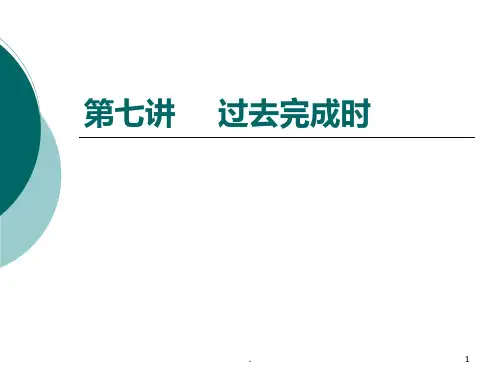
.
4
时间状语
过去完成时的时间状语 before, by the time, until , when, after, once, as soon as
.
5
用法
(1)表示在过去某一时刻或动作以前完成了的动 作,也可以说过去的时间关于过去的动作。即 “过去的过去”。 可以用by, before等介词短语或一个时间状语从 句来表示,也可以用一个表示过去的动作来表示, 还可能通过上下文来表示。 例如: By nine o’clock last night, we had gotten 200 pictures from the spaceship.
but I
in many worse
hotels.
A.was staying
B.stayed
C.would stay
D.had stayed
.
28
6.(08辽宁23) We first met on a train in 2000.We
both felt immediately that we each other for years.
他说他很熟悉她。
I thought I had sent the letter a week before. 我认为我一星期前就把信寄出去了。
.
11
(6) 在过去不同时间发生的两个动作中,发生在前,用过 去完成时;发生在后,用一般过去时。
如when, before, after, as soon,as, till/until引导的
She found the key that she had lost. 她丢失的钥匙找到了。
.
10
(5)过去完成时常常用在told, said ,knew, heard, thought等动词后的宾语从句(或间接 引语)中,这时从句中的动作发生在主句表示的 过去的动作之前。
关于英语过去完成时的用法
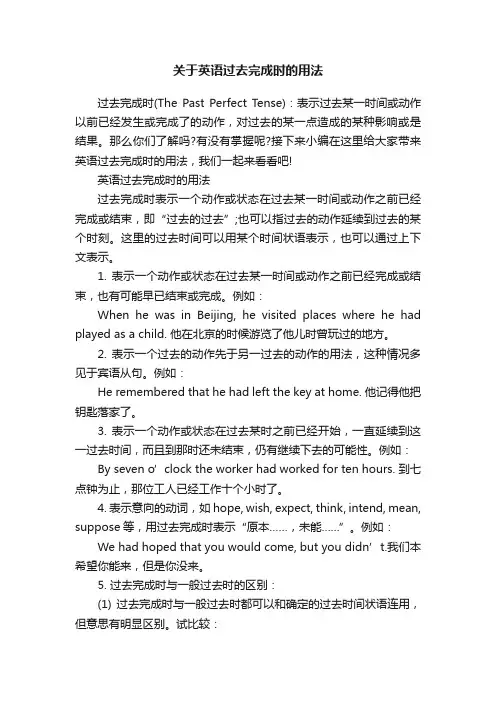
关于英语过去完成时的用法过去完成时(The Past Perfect Tense):表示过去某一时间或动作以前已经发生或完成了的动作,对过去的某一点造成的某种影响或是结果。
那么你们了解吗?有没有掌握呢?接下来小编在这里给大家带来英语过去完成时的用法,我们一起来看看吧!英语过去完成时的用法过去完成时表示一个动作或状态在过去某一时间或动作之前已经完成或结束,即“过去的过去”;也可以指过去的动作延续到过去的某个时刻。
这里的过去时间可以用某个时间状语表示,也可以通过上下文表示。
1. 表示一个动作或状态在过去某一时间或动作之前已经完成或结束,也有可能早已结束或完成。
例如:When he was in Beijing, he visited places where he had played as a child. 他在北京的时候游览了他儿时曾玩过的地方。
2. 表示一个过去的动作先于另一过去的动作的用法,这种情况多见于宾语从句。
例如:He remembered that he had left the key at home. 他记得他把钥匙落家了。
3. 表示一个动作或状态在过去某时之前已经开始,一直延续到这一过去时间,而且到那时还未结束,仍有继续下去的可能性。
例如:By seven o’clock the worker had worked for ten hours. 到七点钟为止,那位工人已经工作十个小时了。
4. 表示意向的动词,如hope, wish, expect, think, intend, mean, suppose等,用过去完成时表示“原本……,未能……”。
例如:We had hoped that you would come, but you didn’t.我们本希望你能来,但是你没来。
5. 过去完成时与一般过去时的区别:(1) 过去完成时与一般过去时都可以和确定的过去时间状语连用,但意思有明显区别。
英语时态:过去完成时
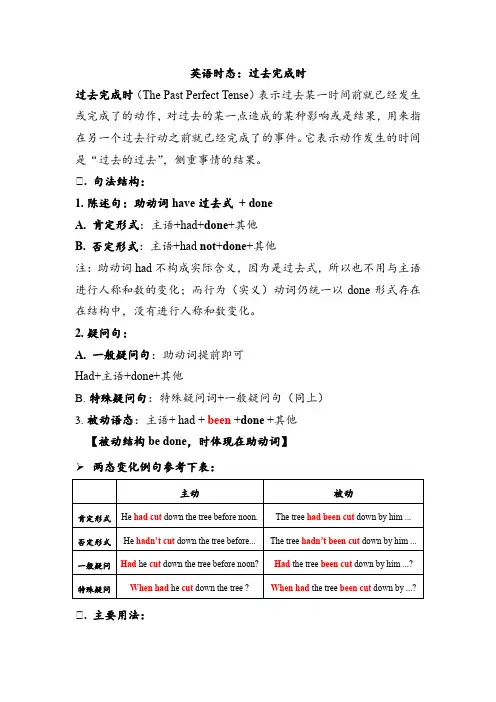
英语时态:过去完成时过去完成时(The Past Perfect Tense)表示过去某一时间前就已经发生或完成了的动作,对过去的某一点造成的某种影响或是结果,用来指在另一个过去行动之前就已经完成了的事件。
它表示动作发生的时间是“过去的过去”,侧重事情的结果。
Ⅰ. 句法结构:1.陈述句:助动词have过去式+ doneA. 肯定形式:主语+had+done+其他B. 否定形式:主语+had not+done+其他注:助动词had不构成实际含义,因为是过去式,所以也不用与主语进行人称和数的变化;而行为(实义)动词仍统一以done形式存在在结构中,没有进行人称和数变化。
2.疑问句:A. 一般疑问句:助动词提前即可Had+主语+done+其他B.特殊疑问句:特殊疑问词+一般疑问句(同上)3.被动语态:主语+ had + been +done +其他【被动结构be done,时体现在助动词】➢两态变化例句参考下表:Ⅰ. 主要用法:过去完成时的主要用法和现在完成时一样。
不同的是,过去完成时把时间推移到了过去某一时间之前,与现在无关。
常与by the end of, by the time ..., before等时间状语连用。
1.过去完成时表示在过去某一时间或动作以前已经完成了的动作。
Helen had left her keys in the office so she had to wait until her husband came home.When we got to the cinema, the film had already begun.2.表示动作在过去某一时间之前开始,一直延续到过去的这一时间,而且还可能继续下去的动作,常和for, since构成的短语或引导的从句连用。
By the time I left the school, he had taught the class for 3 years.He said he had made great progress since he came here.3.放在said,told,asked,thought,wondered等过去时动词的后面,表示在这些动作发生之前已经发生了的事情。
过去完成时-英语语法课件

过去完成时的疑问句 一般疑问句句型:Had + 主语 + 过去分词...? 回答方式: Yes,主语 + had. / No,主语 + had + not.
过去完成时的疑问句是将助动词had置于主语之前(大写had的第一个字母),在句尾 加问号;这种语序是倒装语序:
I visited the museum yesterday. —Had you visited it before? —Yes,I had./No,I hadn’t. 昨天我参观了这个博物馆。 ——你以前参观过这个博物馆吗? ——是,我去过。/没有,我以前没有去过。
过去完成时的肯定句 句型:主语 + had + 过去分词...
过去完成时的肯定句由助动词had加过去分词构成:
He had already been to New York earlier in the week. 本周早些时候他去过纽约。 Jane had just left when you rang. 你打电话时简刚走。
这 时从句的动作和主句的动作发生的先后顺序已经非常明确,这时可以用一般过去时代替过去完成时。 例句: After he arrived in England, Marx worked hard to improve his English. 马克思到达英格兰之后,努力提高他的英语水平。
动词think, want, hope, mean, plan, intend等用过去完成时来表示过去未曾实现 的想法,希望,打算或意图等。
( 3 ) before + 过去的时间点。如: They had planted six hundred trees before last Wednesday. 在上星期三之前,他们已经种了六百棵树了。
过去完成时知识点归纳与总结
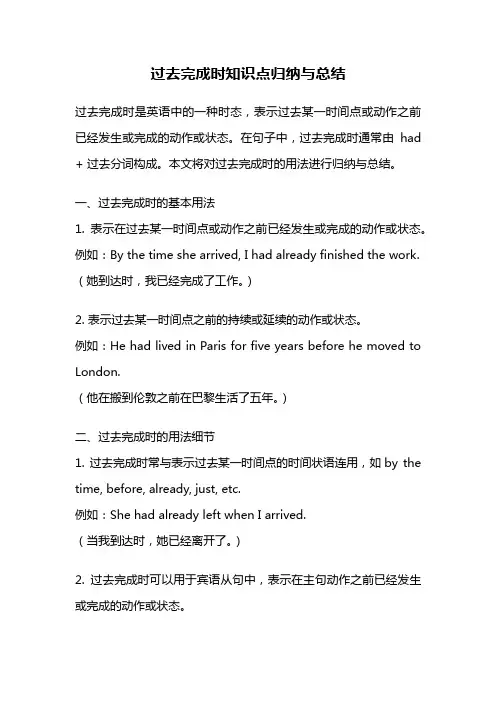
过去完成时知识点归纳与总结过去完成时是英语中的一种时态,表示过去某一时间点或动作之前已经发生或完成的动作或状态。
在句子中,过去完成时通常由had + 过去分词构成。
本文将对过去完成时的用法进行归纳与总结。
一、过去完成时的基本用法1. 表示在过去某一时间点或动作之前已经发生或完成的动作或状态。
例如:By the time she arrived, I had already finished the work.(她到达时,我已经完成了工作。
)2. 表示过去某一时间点之前的持续或延续的动作或状态。
例如:He had lived in Paris for five years before he moved to London.(他在搬到伦敦之前在巴黎生活了五年。
)二、过去完成时的用法细节1. 过去完成时常与表示过去某一时间点的时间状语连用,如by the time, before, already, just, etc.例如:She had already left when I arrived.(当我到达时,她已经离开了。
)2. 过去完成时可以用于宾语从句中,表示在主句动作之前已经发生或完成的动作或状态。
例如:I didn't know that she had already seen the movie.(我不知道她已经看过这部电影。
)3. 过去完成时可以用于条件句中,表示与过去某一时间点相反的假设情况。
例如:If I had known you were coming, I would have prepared dinner.(如果我知道你要来,我会准备晚餐的。
)4. 过去完成时可以用于间接引语中,表示在引述的过去时间点之前已经发生或完成的动作或状态。
例如:She told me that she had already finished her homework.(她告诉我她已经完成了作业。
初中英语语法——过去完成时
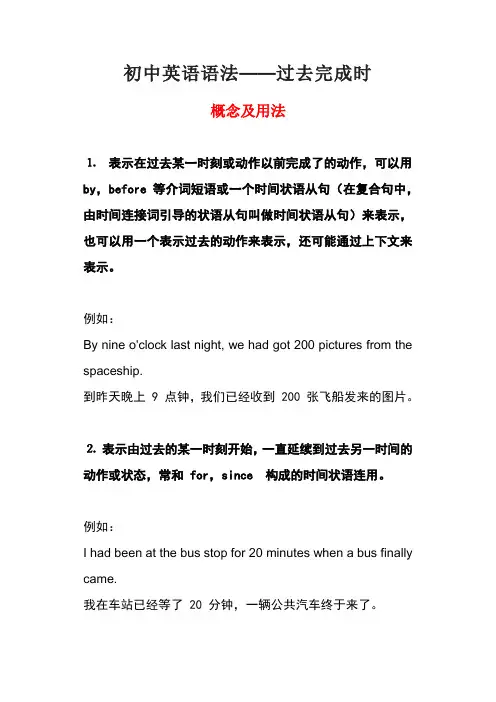
初中英语语法——过去完成时概念及用法⒈表示在过去某一时刻或动作以前完成了的动作,可以用by,before等介词短语或一个时间状语从句(在复合句中,由时间连接词引导的状语从句叫做时间状语从句)来表示,也可以用一个表示过去的动作来表示,还可能通过上下文来表示。
例如:By nine o'clock last night, we had got 200 pictures from the spaceship.到昨天晚上 9 点钟,我们已经收到 200 张飞船发来的图片。
⒉表示由过去的某一时刻开始,一直延续到过去另一时间的动作或状态,常和 for,since构成的时间状语连用。
例如:I had been at the bus stop for 20 minutes when a bus finally came.我在车站已经等了 20 分钟,一辆公共汽车终于来了。
⒊叙述过去发生的事情,在已叙述了过去发生的事情后,反过来追述或补充以前发生的动作时,常使用过去完成时。
例如:Mr.Smith died yesterday. He had been a good friend of mine.史密斯先生昨天就去世了。
他以前是我的好朋友。
⒋在含有定语从句的主从复合句中,如果叙述的是过去的事,先发生的动作常用过去完成时。
例如:I returned the book that I had borrowed.我已归还了我借的书。
She found the key that she had lost.她发现她失去了的钥匙。
⒌过去完成时常常用在told,said,knew,heard,thought 等动词后的宾语从句(或间接引语)中,这时从句中的动作发生在主句表示的过去的动作之前。
例如:He said that he had known her well.他说他早就很了解她了。
⒍状语从句:在过去不同时间发生的两个动作中,“发生在过去的过去”,用过去完成时;发生在后,用一般过去时。
英语:过去完成时态
Eg. 1.When I got to the cinema, the film had begun for ten minutes. 2.When I got to the cinema, the film had been on for ten minutes. 3.He said the door had been opend for long. 4.He said the door had opened for long. 5.He said the door had been open for knew, heard, thought 等引导的 宾语从句中。 Eg. He told me that he had heard of it. I thought my homework had been fininshed. But I didn’t. 3、 从过去开始, 一直持续到过去的另一时间 的动作、状态。常用since,for. Eg. She said that she had learned English for years since he came to our school 注意:瞬间动词不能和一段时间状语,及since, for 引导的从句和短语连用。
常用的时间状语等标志词: 1、by, before, when, by the time等构成的短语 或引导的从句。 Eg. 1)By the time she came to the bus stop, the bus had already gone. 2) We had finished the task before midnight. 3) When I arrived at the post office, I found that I had left the letter at home. 4) After I had finished my homework, I went to bed.
英语语法之过去完成时
b. 用when ,before, after 等引导的时间状语从句。 The train had started before we got to the station. The plane had taken off when I reached the airport.
2. 过去完成时还可以表示过去某一时间以前发 生开始的动作持续到这一过去的时间。常与 for, since引导的表示一段时间的短语或从句 连用。如: I had worked in a hospital for three years before I came here. He told us that he had worked here since 10 years before.
过去完成时
过去完成时表示在过去某一时刻或某一动 作之前已经发生的动作或情况,即:过去 的过去。构成: ha成时表示在过去某一时间之前已经 完成的动作,表示对这一过去时间造成的 结果或影响。常用以下几种方式: a. 用by, before 等构成的介词短语。如: Linda had learnt 10 English songs by the end of last month. John had repaired that machine before midnight.
时态—过去完成时(英语语法课件)
过去完成时 Past Perfect Tense
Boy: I had been really tired before I went to bed. Girl: What had you done before you went to bed? Boy: I had played football before I did my homework, so I stayed up late last night. Girl: Well, you should finish your homework first and have a good rest.
延伸用法
1. 过去完成时常常用在told, said, knew, heard, thought等动词后 的宾语从句(或间接引语)中,这时从句中的动作发生在主句表示 的过去动作之前。 例如:He said that he had known her well.
I thought I had sent the letter a week ago.
否定句
主语+had not+动词的过去分词 She had not read the book.
疑问句
Had+主语+动词的过去分词 Had she read the book?
Yes, she had. No, she hadn’t .
PART 02
过去完成时的主要用法
过去完成时的主要用法
1. 表示在过去某一时间或动作以前已经完成了的动作,即“过去 的过去”。这个过去的时间常用by, before, when等介词短语或 一个时间状语从句表示,也可以暗含在上下文中;
2.自从他离开南京我们就一直没有见过面。 We haven’t seen each other since he left Nanjing. 3.到上学期末,我们已经学习了4000多个单 词。 By the end of last term, we had learnt over 4,000 words.
英语语法总结:过去完成时
英语语法总结:过去完成时过去完成时:1.构成:had + 过去分词2.功能:(1)表示过去某个动作或某个具体时间之前已经发生、完成的动作。
“过去的过去”。
►. They had got everything ready before I came.►. The play had begun before I got to the theater with my boyfriend.(2)过去完成时常用于hardly / scarcely ... when, no sooner ... than等固定句型结构中。
(此乃超级重点句型,意为:“一……就”)►. She had hardly / scarcely gone to bed when the bell rang.►. No sooner had he arrived at the railway station than he met her parents.(注意no sooner 在句首时句型倒装。
)(3)intend(打算),mean(意味),hope(希望),want(想要),plan(计划)等动词的过去完成时用来表示本打算做而没有做的事。
►. I had intended to call on you yesterday, but someone came to see me just when I was about to leave.(……原想昨天去看你……)►. They had planed to hold a football match last week, but they had to cancel it because the bad weather. (……原计划上周举行一场足球赛……)。
- 1、下载文档前请自行甄别文档内容的完整性,平台不提供额外的编辑、内容补充、找答案等附加服务。
- 2、"仅部分预览"的文档,不可在线预览部分如存在完整性等问题,可反馈申请退款(可完整预览的文档不适用该条件!)。
- 3、如文档侵犯您的权益,请联系客服反馈,我们会尽快为您处理(人工客服工作时间:9:00-18:30)。
用法:
过去完成时与when, before, as soon as, till/ until 等引导时间状语的从句连用, 强调动作发生的时间前后。
By Villa
构成:助动词had + 动词的过去分 词(V.pp)
用法:
1. 过去完成时动词表示过去某一时间或某 一动作之前完成的动作或状态。在强调过 去某一动作发生在另一动作之前时。
在强调过去某一个动作发生在另一个动作前常常用 过去完成时态。
1.他说他以前见过你。 He said that he ____h_a_d__se_e_n____ (see) you before.
stop ---- stopped drop ------- dropped
2. 不规则动词的变化见课本 94---96 页
用法:
2. 过去完成时词可以表示过去某一 时刻之前发生的动作或呈现的状态, 这一动作一直持续 或将继续下去。
1. 到了六点钟为止,他们已经工作了八小时了。
By six o’clock they __h_a_d_w__o_r_k_e_d_ (work)for eight hours.
b) 以 e 结尾的动词直接加 d
use ------ used
refuse ------ refused
c) 以辅音字母加 y 结尾的动词,把 y 改 i 再加 ed
study ----- studied carry ----- carried
d) 以重读闭音节结尾的,前面有单个元音字母时, 双写辅音字母,再加 ed
例如:1. 她到家之前她的孩子已经睡着了。 When she got home her children ___h_a_d__s_le_p_t__(sleep).
2. 在他们到达之前电影已经开始了。 Before they arrived here the film ___h_a_d____ already ___st_a_r_t_e_d___ (start).
5. My friend __b_o_u_g_h_t___ (buy) the car two years ago.
He ____h_a_s__h_a_d______ (buy) it for two years.
此课件下载可自行编辑修改,供参考! 感谢您的支持,我们努力做得更好!
1. 到昨晚上,他已写完那封信。 By yesterday evening he _h_a_d__w_r_it_t_e_n_ (write) that letter. 2. 他说他以前见过你。 He said that he __h_a_d__s_e_en____(see) you before.
3. 当我进来时,他已做完了作业。 When I came in he ___h_a_d__fi_n_i_sh_e_d____(finish) his homework.
3. 我完成作业了就去睡觉了。 Last night, as soon as I ___h_a_d__fi_n_is_h_e_d___ (finish) my work I went to sleep.
1. After he __h_a_d__fi_n_is_h_e_d___ (finish) his work he went out.
2. 到六点钟为止他们已经工作八小时了。 By six o’clock they ___h_a_d__w_o_r_k_e_d__(work) for eight hours.
过去分词的构成: 过去完成时的构成:由助动词 1. 规则动词的变化: had + 动词的过去分词(V.pp)
a) 一般情况下在动词后面加 ed work ------ worked play -------- played
过去完成时与 by then(截止到那时); by 9 o’clock(直到 九点钟) by the end of …(在…结束/末之前); by the time…(在…时之前); up till then (直到那时); up until last night(直到昨晚)等连用,表示过去的过 去。
用法:
3. 过去完成时和 already, just, ever, yet 等连用表示过去的过去。
例如:1. 他告诉我说他们队已经赢了。 He told me that his team ___h__a_d___ already ____w_o_n_____ (win).
2. 她说她仍没去过长城。
2. The children ran away after they __h_ad__b_r_o_k_en__ (break) the window. 3. I went to Tom’s house but he __h_a_d__g_o_n_e_ (go) out.
4. Annie told me that his father ___h_a_d_g_o_n_e___ ( go ) to Paris and he __w_o_u_l_d_c_o_m__e_ ( come ) back in a few days.
2. 我到广州时,他在那里很长时间了。
When I ___(be) there for a long time.
3.到上个月中旬我们在北京住了有五年时间了。
By the middle of last month we ___h_a_d_l_i_v_ed_____(live) in Beijing for five years.
